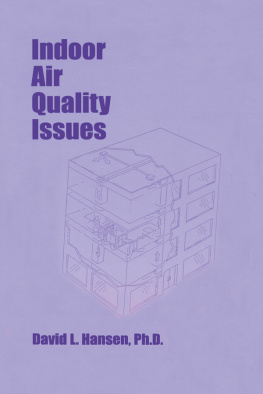
INDOOR AIR QUALITY ISSUES
INDOOR AIR QUALITY ISSUES
David L. Hansen, Ph.D.
Environmental Consultant

| USA | Publishing Office | Taylor &Francis
29 West 35th Street
New York, NY 10001-2299
Tel: (212)216-7800 |
| Distribution Center | Taylor & Francis
47 Runway Road, Suite G
Levittown, PA 19057-4700
Tel: (215)269-0400
Fax: (215)269-0363 |
| UK | Taylor & Francis | 11 New Fetter Lane
London EC4P 4EE
Tel: 011 44 207 583 9855
Fax: 011 44 207 842 2298 |
INDOOR AIR QUALITY ISSUES
Copyright 1999 Taylor & Francis. All rights reserved. Except as permitted under the United States
Copyright Act of 1976, no part of this publication may be reproduced or distributed in any form or byany means, or stored in a database or retrieval system, without prior written permission of the publisher.
A CIP catalog record for this book is available from the British Library.
Reprinted 2010 by CRC Press
CRC Press
6000 Broken Sound Parkway, NW
Suite 300, Boca Raton, FL 33487
270 Madison Avenue
New York, NY 10016
2 Park Square, Milton Park
Abingdon, Oxon OX14 4RN, UK
Library of Congress Cataloging-in-Publication Data
Hansen, David L.
Indoor air quality issues / David L. Hansen.
p. cm
Includes bibliographical references and index.
ISBN 1-56032-866-5 (alk. paper)
1. Indoor air pollution. 2. Air quality management. 3. BuildingsEnvironmental engineering. I. Title.
TD883.17 .H36 1999
363.7392dc21
99-35846
CIP
CONTENTS
This book is a guide about the nonindustrial indoor environment and how it relates to the welfare and well-being of its occupants. It is designed for people in the environmental sciences/health field and will also appeal to readers interested in becoming environmental practitioners. However, since indoor environmental issues play such a large part in everyones day-to-day existence, this book can also assist those who will not in this field.
The book uses a multidisciplined approach in examining the causes and effects of the interactions between occupants and the nonindustrial environment (i.e., offices and homes). This multidisciplined approach encompasses numerous elements pertaining to the indoor environment, including medical aspects, chemical and microbial concerns, building design and ventilation systems, psychological aspects, conducting investigations, and pro-active programs to prevent problems.
It is essential to be aware that information in this field is increasing dramatically. In addition to whatever new books are published in the future, the primary sources for staying up to date are governmental agencies and professional organizations. The most important U.S. government agencies are the Environmental Protection Agency (EPA), the Centers for Disease Control (CDC), and the Occupational Safety and Health Administration (OSHA), which maintain websites and offer publications. Important professional organizations include the American Society of Heating, Refrigerating and Air-Conditioning Engineers (ASHRAE), the American Industrial Hygiene Association (A1HA), and the International Society of Indoor Air Quality and Climate (ISIAQ). In addition to their websites, these organizations publish journals, sponsor conferences, and issue conference proceedings.
LEARNING OUTCOMES
An understanding of important facts and principles concerning the health and well-being of occupants in nonindustrial settings
An understanding of how materials and conditions in nonindustrial settings can pose a threat to the health and welfare of the occupants
An ability to apply principles to help mitigate problems and also to help prevent them
Text Structure
This book consists of eight chapters: (1) History and Evolution, (2) Building-associated Illnesses, (3) Building Design and Air Quality, (4) Volatile Organic Compounds, (5) Microbial Contamination, (6) Impact of Psychosocial and Other Factors, (7) Diagnosing IAQ Problems, (8) Pro-active Ways of Reducing IAQ Problems. Each chapter includes an overview, learning outcomes, discourse, suggestions for evaluation, key words and concepts, and two reference lists, one for the text and the other with suggested readings for additional information on the chapter topic.
Acknowledgements
I gratefully acknowledge the input of Drs. David Grimsrud and Richard Gammage. Their and were invaluable.
I wish to thank Dr. Claudia Sisson for her support and for the suggestion that led to this book.
Finally, I will be forever grateful toand dedicate this book tomy wife, Ruth Charnes, whose love, understanding, and editorial talents have made this book possible.
Chapter
HISTORY AND EVOLUTION
OVERVIEW
The indoor environment is currently considered to be one of the most important health concerns for industrialized nations. How did this concern evolve? This chapter gives a brief overview of some of the major changes in the indoor environment and how those changes have impacted on occupants comfort and health, concentrating on Europe and, most recently, the United States.
The chapter begins with a brief look at attempts to control the indoor temperature and at early theories about the impact of the indoor environment on occupants. The rest of the chapter reviews the significant changes in the indoor environment that began after World War II with a dramatic increase in the use of synthetic materials and chemicals that produced potentially harmful indoor contaminants. Next, the energy crisis of the early 1970s dramatically altered building design and ventilation to produce tight structures. The combination of synthetic materials and changes in building design are the major causes of poor indoor air quality today.
This chapter also looks at another crucial factorpeoples perception of the indoor environment. Recent enormous media attention to potential health hazards like asbestos has promoted widespread fears that the indoor environment can cause cancer and other health problems.
LEARNING OUTCOMES
A knowledge of the evolution of the indoor environment
A greater understanding of the recent changes in the indoor environment
An appreciation of the increased complexity of the indoor environment
EARLY DWELLINGS
Temperature and Comfort
The driving force throughout the evolution of the indoor environment has been comfort. Temperature is the parameter most closely associated with comfort, and a comfortable temperature has been the primary goal ever since people built permanent structures. Until relatively recently, most efforts concentrated on heating rather than cooling.
A comfortable temperature, generally considered about 72 degrees F, is essential for the perception of an acceptable indoor environment (Berglund 1989). Air that is significantly above a comfortable temperature will be perceived as stale and stuffy even if the air is actually fresh.
Hippocrates, in Airs, Waters, and Places, states that climate has great effects on the physique, intelligence, and temper of people (Bedford 1964). Although Hippocrates was probably referring to the outdoor environment, the indoor climate controls comfort, which certainly impacts on an occupants temperament and performance, if not intelligence and physique.








